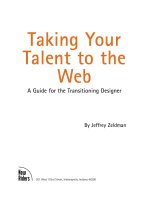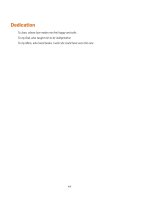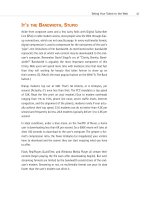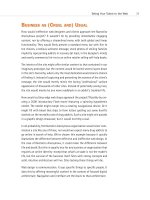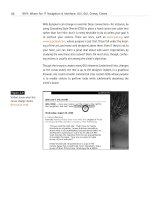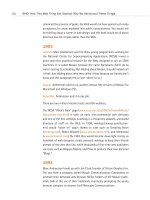Taking Your Talent to the Web- P28 pdf
Bạn đang xem bản rút gọn của tài liệu. Xem và tải ngay bản đầy đủ của tài liệu tại đây (154.55 KB, 15 trang )
16 0732 CH12 4/24/01 11:25 AM Page 386
chapter 13
Never Can Say Goodbye
YOUR DIALOG WITH THE WEB has now begun. And though this book, like young
love, must end, our conversation will continue. You will find us, and we will
find you on the pages of the World Wide Web.
No book (indeed, no five-year program, if one existed) could teach you
everything you need to know to design smart, attractive, user-focused
websites. You will learn as you work—from teammates, partners, and even
your clients.
You also will learn a great deal from the people who visit your sites. You’ll
be surprised at how many write—and not merely to complain when your
single-spaced, 10px type sends them scurrying to the optometrist.
But some of the best places to learn are on the Web itself, hence this chap-
ter. In it we share our favorite online resources and explain the importance
of continuing your education as the Web and your career experience
growth and change.
SEPARATION ANXIETY
Throughout this book, we’ve shown methods used to design today’s Web
and shared theories about how people interact with the medium. You need
to know these things to begin working now.
17 0732 CH13 4/24/01 11:25 AM Page 387
But as we’ve also pointed out, the Web is changing; indeed, like the sea, or
like some other Zen metaphor we can’t quite put together here, the Web’s
very nature is one of constant change. Currently the Web is changing in an
intriguing way—one that will move it closer to its founders’ original vision
of an open medium, accessible by all people and available to all sorts of
Internet-enabled devices.
What will empower that happy change? It will come with the separation
of style from content. What does that mean? It means you’ll stop welding
your texts and functions and images together through overextended HTML.
Instead, you’ll keep your visual design in one place (a Cascading Style
Sheet) and your content in another (a series of HTML or XHTML documents;
a database of XML-formatted text). The twain will meet on the web page,
but their behind-the-scenes separation will considerably enhance your
working conditions and your audience’s experience.
Instead of painstakingly slicing apart images in Photoshop as described in
this book or spending hours hand-tweaking hundreds of individual HTML
documents, you’ll have time to spend on more interesting pursuits such as
design itself—which is, after all, what you do.
This change in the nature of web design as a practice will come when all
web users employ browsers that fully support the standards that empower
us to separate style from content: HTML/XHTML, CSS, XML, JavaScript/
ECMAScript, and the DOM.
Not only do browsers have to change (and they are changing), web design-
ers must also change—a proposition that requires the willingness to con-
tinue learning and to risk discarding methods we’ve spent years perfecting.
In February 2001, A List Apart reinvented itself with a standards-compliant
design that separates style from content ( />stories/99/). As you might expect, the site (www.alistapart.com) is a good
resource for information on that subject.
The reinvention of ALA coincided with The Web Standards Project’s Browser
Upgrade campaign ( which urges
web designers to learn about and use the W3C recommendations we’ve
388
HOW: Never Can Say Goodbye: Separation Anxiety
17 0732 CH13 4/24/01 11:25 AM Page 388
discussed in this book, even if the resulting sites look less than delicious in
older, nonstandards-compliant browsers. The Browser Upgrade campaign
also asks web designers and content creators to seek ways to encourage
user upgrades so that the Web can improve without leaving anyone behind.
The Browser Upgrade campaign and the ALA redesign were logical next
steps in the evolution of the Web. We launched them while writing this
book, which brings up the problem with books. Namely, while books have
the virtue of permanence, they cannot update themselves as websites can.
We encourage you to continue learning by visiting educational and inspir-
ing websites and reading and participating in web design mailing lists and
forums.
The remainder of this chapter will provide you with plenty to choose from.
Use these resources to amplify parts of this book and to learn more about
the emerging, standards-based Web. At the end of the annotated list below,
we’ll return to offer a final thought about the Web and you.
FROM TAG SOUP TO TALK SOUP: MAILING
LISTS AND ONLINE FORUMS
Learning by trial and error is part of any process and is certainly part of web
design. Learning from other members of your team is a deeply bonding
experience, but learning (and sharing your own knowledge) on a mailing
list is a pleasure no web designer should miss.
There are many, many mailing lists and online communities for web design-
ers and developers. Some focus on specific technologies; others are vast,
crowded, and general. Some function as job referral services while others
mainly promote the people who created the list. Some are chaotic, others
restrictive. With a little effort, you will find the ones that make you feel
most comfortable.
Following, in alphabetical order, are some of our favorites.
389
Taking Your Talent to the Web
17 0732 CH13 4/24/01 11:25 AM Page 389
A List Apart
/>Each week A List Apart publishes useful tutorials (“Meet the DOM,” “Fear
of Style Sheets”), challenging opinion pieces (“The Curse of Information
Design,” “Sympathy for the Plug-in”), or both. And each week, after read-
ing these articles, ALA readers respond on the site’s discussion forum. The
site is noncommercial, and you need not reveal your identity or other per-
sonal information to participate in the discussion forums.
Astounding Websites
/>Launched by Glenn Davis and maintained by Dave Bastian, this unique dis-
cussion community was created to honor the best writing, design, and pro-
gramming on the Web. Visit this small, friendly forum to discover inspiring
commercial and noncommercial sites or participate by reviewing sites you
admire. You can also submit your own sites for review in the Site Promo-
tion section.
The Babble List
/>Maintained by Christopher Schmitt (and resurrected by him in 2001 after
a brief hiatus), The Babble List is a well-run general web design mailing list,
covering issues of graphic design, information architecture, writing, usabil-
ity, project management, and related skills. Though the average Babble Lis-
ter is a professional with at least two years’ experience, the list is
beginner-friendly. If you find yourself stuck on a JavaScript or CSS prob-
lem or wondering why your site looks great in one browser but poor in
another, you can post your message to The Babble List and anticipate use-
ful feedback.
390
HOW: Never Can Say Goodbye: From Tag Soup to Talk Soup
17 0732 CH13 4/24/01 11:25 AM Page 390
Dreamless
/>Dreamless is a deep and open community primarily populated by young
graphic designers and Flash artists. Though the site’s gray-on-gray, Arial-
only design gives it a somber appearance, it’s anything but dull. Dreamless
discussions range from the seriously spiritual to the deliberately silly. The
site has a fanatical following and encourages its members to get together
at parties in various cities. If you have trouble finding the site’s front door,
use View Source.
Evolt
/>Evolt, a multi-faceted mailing list, online message board, and member-cre-
ated publication, provides useful dialog spaces for technically minded web
designers and developers worldwide. Accessibility and web standards are
hot topics here, and you can learn simply by reading other members’ posts.
Like all communities mentioned here, Evolt is self-policing; and like all suc-
cessful communities, it manages the task unobtrusively.
Metafilter
afilter.com/
Matt Haughey’s noncommercial community site is not about web design
or web programming, but many web content creators will be found in its
forums. Billing itself as a “community weblog,” the occasionally raucous
discussion site can help you get a handle on aspects of the Web’s emerg-
ing culture. This in turn will remind you that the Web is not about HTML
tags or graphic design; like Soylent Green, the Web is people.
391
Taking Your Talent to the Web
17 0732 CH13 4/24/01 11:25 AM Page 391
Redcricket
/>Dan Beauchamp’s personal site includes a web design forum (“Commu-
nity”) that’s small, lively, and friendly. HTML questions? JavaScript woes?
Redcricket could be the ticket. By maintaining a fairly low profile, Red-
cricket’s forum generally avoids the flame wars and ego trips that some-
times plague other lists and communities. Spend time at the site before you
post. Redcricket is a tight community of friends; barging in and loudly
demanding attention won’t go over well.
Webdesign-l
/>Stewarded by Steven Champeon, Webdesign-l is a long-running, smartly
focused design and development list. Some of the brightest people in the
industry participate in this highly respected list. Champeon, a systems guru
who technical-edited Taking Your Talent to the Web and who co-founded
The Web Standards Project, runs a tight ship. As list administrator, he keeps
misinformation to a minimum and stops bad behavior before it starts.
Beginner questions might be well-received if submitted with restraint.
(“Hellllllp! My site is hosed!!!!!!” will probably not generate the kind of
feedback you want.) Read the list rules and get used to the general dis-
cussion tone before posting to the list.
When All Else Fails
/>Consider a class. R35edu offers a curriculum of over 60 courses, covering
nearly every facet of web strategy, design, development, commerce, and
marketing—all via “a unique distance learning environment that puts you
in direct contact with creative innovators and designers from all over the
world.”
392
HOW: Never Can Say Goodbye: From Tag Soup to Talk Soup
17 0732 CH13 4/24/01 11:25 AM Page 392
EYE AND BRAIN CANDY: EDUCATIONAL AND
INSPIRING SITES
Attempting to figure out web design exclusively from a book is like trying
to learn about music without listening to any. Fortunately, the Web is rich
in inspiring and educational sites. Following are a few of our favorites,
including a couple of our own (cough).
Design, Programming, Content
A List Apart ( “for people who make websites.
From pixels to prose, coding to content.” See previous section for more
on this.
Apple Internet Developer ( launched
in 2001, started small, but what it has is choice: brief and pungent tutori-
als on HTML, online typography, CSS, JavaScript, and the DOM.
Builder ( “solutions for site builders,” provides
articles and tutorials on graphic design, multimedia, back-end develop-
ment, and even software (“Fireworks vs. ImageReady”). There is also a dis-
cussion board (Builder Buzz), and the site hosts a dandy annual web design
conference in New Orleans.
Each month, Digital Web ( “the web
designer’s online magazine of choice,” brings you fresh interviews, tutori-
als, columns, and even classifieds (to help you get your next job). Edited
and published by Nick Finck, who also contributes to A List Apart.
Web Page Design for Designers ( published monthly by
Joe Gillespie, is “aimed at people…already involved with design and typog-
raphy for conventional print, [who] want to explore the possibilities of this
new electronic medium.” In other words, it speaks to the audience of this
very book! (We would have titled this book “Web Design for Designers” if
Joe hadn’t beaten us to the punch, darn him.) The site includes typefaces
optimized for the Web, columns on web design and typography, and a solid
listing of third-party resources.
393
Taking Your Talent to the Web
17 0732 CH13 4/24/01 11:25 AM Page 393
The Web Standards Project ( co-founded
by Glenn Davis, George Olsen, and your humble author, maintains a
Resources section for your educational pleasure. Confused about CSS,
ECMAScript, and the rest of the alphabet soup? You’ll find links to relevant
articles here.
Web Techniques ( is a vast, professional
publication with an accompanying real-world magazine you can read in
the bathtub or carry in your attache case. It covers web technology and
business and can help you understand how wireless technology interfaces
with web design.
Web Review ( publishes some of the smartest
tutorials we’ve ever seen on XHTML, JavaScript, and other web technolo-
gies and has always been a great friend to web standards. Highly recom-
mended, particularly for those who wish to understand web technologies
instead of simply pushing buttons in WYSIWYG editors.
Think of Webmonkey ( originally directed by
Jeff “Art & Science of Web Design” Veen, as Builder.com with more atti-
tude. A deep resource dating back to the earliest days of the designed Web,
the site sports swell tutorials on HTML, JavaScript, and other technologies,
along with columns and articles on streaming media, emerging standards,
and the web business. Not updated as often as it used to be, but still a fine
smoke.
Webreference ( a subsidiary of
Internet.com (yes, there really is an Internet.com), is tailored more
to developers than designers but will repay your exploration. Edited by
Andy King, the vast site covers everything you could ever want to know on
the web technology front. Interviews and discussion forums enhance the
site’s value.
Webtype ( dedicated to better online typogra-
phy, keeps you posted on this vital and sadly under-reported topic. (Some-
times web designers seem more interested in scripting and gimmicks than
they are in ensuring that type is legible—let alone attractive and pleasur-
able to read.) Webtype gives you the lowdown on everything from
394
HOW: Never Can Say Goodbye: Eye and Brain Candy
17 0732 CH13 4/24/01 11:25 AM Page 394
readability studies and CSS nuances to typographic explorations and
downloadable typefaces. Don’t miss the survey of fonts installed on PC and
Mac users’ computers. Founded by the mysterious “Gen,” with kibitzing
from Dave Bastian, Joe Clark, Julia Hayden, Webmistress Jo, and your hum-
ble author.
The World Wide Web Consortium ( the mother of us all, is
the final authority on web standards. Use it to keep track of existing and
emerging technologies and to verify the way these technologies should
work, before running off half-cocked, screaming about aliens jamming the
radio transmitter embedded in your skull as part of an evil CIA experiment.
Note that W3C articles, while definitive, are among the least easy to read
and understand of any we’ve seen—and that includes VCR manuals writ-
ten in Japan. You’ll do better if you check W3C to see what you should learn
about; then read the friendly tutorials at Webmonkey, Builder, or A List
Apart.
The Big Kahunas
Let us now praise famous art directors:
Adobe ( not only makes great software for print
and web designers, they also run a fine, vast site full of tutorials, columns,
and articles on web, print, and motion design. Disclaimer: Your humble
author writes a column for this publication.
AIGA ( the American institute of Graphic Arts, has a
long and noble history as a membership organization for designers. But you
know that. The site helps you track seminars and conferences and offers a
national job bank and member discussion board along with thought-
provoking articles (“What is Graphic Design?”).
Communication Arts ( is among the world’s
most-respected voices for design. Its interactive section includes design
technology columns and a Website of the Week. And of course the Com-
munication Arts annuals honor some of the best design and advertising
communications in the world.
395
Taking Your Talent to the Web
17 0732 CH13 4/24/01 11:25 AM Page 395
PDN-Pix ( the digital arm of Photo District
News, provides web design features (“Waiting to Load”), Q&A (“Ask Pix”),
reviews of noteworthy sites (“Pix’s e-Projects”), and a column by your hum-
ble author (“Second Site”). The print magazine will repay your interest;
much of this material gets republished on the site along with some web-
only content (“Grand Masters of Flash”).
Beauty and Inspiration
When grinding out menu bar buttons saps your inspiration, trust well-
designed, meaningful sites to restore it. Begin your voyage with sites that
deliver compelling, original content (and not in plain brown wrappers):
{fray} ( the ultimate personal storytelling site, was
conceived, produced, and art-directed by designer/author Derek Powazek.
In addition to showcasing what an imaginative web designer can do with
words and pictures, the site functions as an on and offline community.
Highly recommended. (Derek Powazek is also the author of Design For Com-
munity, published by New Riders.)
Glassdog ( Lance Arthur’s personal magnum
opus, is both sarcastic and smooth. As if the site’s clever writing and smart
scripting were not intimidating enough, Arthur manages to combine clean,
spare, easy-to-navigate design with the technical dexterity of a dazzling
showoff.
Harrumph! ( Heather Champ’s charming and
witty online diary, sports one of the cleanest web layouts we know. Perhaps
this is because Heather has been designing websites since 1995, or perhaps
it’s because she’s got taste. All we know is, every site that uses words
should be this easy to read and engaging to look at. Few are.
Media.org ( “a collective of artists/architects…
fueled by a passion for the Internet medium,” was cofounded by Carl Mala-
mud and Webchick in 2000 to debunk web inanities, promote web intelli-
gence, and rescue digital works laid waste by careless businesses. Among
the sites they rescued:
396
HOW: Never Can Say Goodbye: Eye and Brain Candy
17 0732 CH13 4/24/01 11:25 AM Page 396
Mappa Mundi ( a smart, monthly web-only
magazine and another Malamud/Webchick production, is perhaps the most
intellectual of the noncommercial online ‘zines.
Spark Online ( is an extremely ambitious
monthly online magazine covering media, trends, and society. Like all the
others mentioned here, it is essentially a nonprofit labor of love.
The preceding sites show what can be done when original minds combine
fresh content with fine style.
Those directly following show what can be accomplished when innovation
and skillful graphic design are combined. Indeed, most of the following
sites exist solely for that purpose, though a few are also commercial in
nature.
Many of the sites listed require Flash and QuickTime, and it helps to have
a recent browser and a fast connection.
Amon Tobin Supermodified ( previously men-
tioned in these pages, is an extraordinary music site created in Flash. A
cold, high-tech look, with a warmly interactive embrace, the site will
reward your patience.
Archinect ( an ever-changing visual explo-
ration, should be seen and not described.
Assembler ( Brent Gustaffson’s masterpiece of
cross-browser DHTML programming has a lovely and understated design
sensibility.
Born Magazine ( is a long-running, ambi-
tious, collaborative work that attempts to continually reinvent the con-
junction between word and image. The noncommercial site’s tagline is
“Design. Literature. Together.”
Egomedia ( is a design company portfolio with
the sensibility of a rock video. Requires Flash.
397
Taking Your Talent to the Web
17 0732 CH13 4/24/01 11:25 AM Page 397
Lushly designed eneri.net ( makes no bones about
narrowing its audience: “This site targets luxurious people with a fast com-
puter, fast Internet connection, Netscape or IE 4.0 or above, and Shockwave
7 plug-in.” For those who meet the requirements, Irene Chan’s labor of love
offers a beautiful, film-like experience.
Entropy 8 Zuper ( is the site of Auriea Harvey, one
of the first web designers to laugh at conventions and bust boundaries.
Requires “fast computer, DHTML browser, Flash 5 or better” and “a physi-
cal need for wonder and poetry.”
Futurefarmers ( Amy Franceschini’s web
and multimedia design company, gives the lie to the notion that corporate
work must be staid and conservative. Amy is one of the original exponents
of fine design on the Web; her early web work is housed permanently at
the San Francisco Museum of Modern Art.
Gmunk ( a high-density personal site, pushes the
envelope every which way. Outrageously high bandwidth, QuickTime
movies, layered Photoshop collages rendered in Flash: everything usability
experts rail against is practiced here, by a master who can get away with
it. Tune in after losing an argument with your information designer or your
client.
Interiors ( is a dynamic slideshow
of digital self-portraits by artist Steve Giovinco. To call the work “disturb-
ing” would be an understatement. It’s also quite powerful.
Monocrafts ( combines powerful visual content
with unbelievably innovative interface ideas—extremely inspiring.
One9ine ( a web design agency created by
designers, not marketers, is gorgeously rich yet entirely functional and easy
to navigate. Think the two can’t coexist? Look and see.
Once Upon A Forest ( is an abstract,
deliberately cryptic work of genius by Joshua Davis, who also brings us
Praystation and Dreamless.
398
HOW: Never Can Say Goodbye: Eye and Brain Candy
17 0732 CH13 4/24/01 11:25 AM Page 398
S.M. Moalie’s Photomontage ( makes us
cry. ‘Nuff said.
Marc Klein’s Pixel Industries ( well
known and widely imitated, is a textbook example of the graphic-design-
lead approach to web development. See also Marc’s Creative Republic
(
Pixelflo(http://pixelflo.com/), funky and witty, is also a masterpiece of
JavaScript programming.
Praystation ( Joshua Davis’s site, is dedicated
to exploring and enlarging the boundaries of Flash and interface design. If
you are learning Flash and beginning to think you know what it can and
can’t do, check Praystation. Davis gives away his source code so others can
use it in their design projects.
Presstube ( James Patterson’s personal illus-
tration portfolio, reveals mastery of Flash as well as considerable drawing
skill.
Projectbox ( is an unusually elaborate, strik-
ingly designed illustration and design portfolio site made in Thailand by 22-
year-old Krisakorn Tantitemit. The playful and well-crafted interface makes
great use of frames and scripting, and the color combinations are uniquely
dramatic and pleasing.
Josh Ulm’s collaborative Remedi Project (remediproject.
com/) is a bleeding-edge leading light. Requires a modern browser, a fist-
ful of plug-ins, and a fast connection (or great patience).
Mike Cina’s Trueistrue ( is a completely unique,
ever-changing, strangely minimalist exploration of line and form.
Volumeone ( is Matt Owens’s masterpiece.
Updated quarterly, the site explores abstract visual issues through Flash
and Photoshop.
399
Taking Your Talent to the Web
17 0732 CH13 4/24/01 11:25 AM Page 399
Yenz: The Secret Garden of Mutabor ( is a navigable
space of large, striking images that load quickly because they are entirely
vector-based. Created in Illustrator, Freehand, and Flash 3, the site guides
you through one rich image field after another. The effect is both mesmer-
izing and soothing.
ZX26 ( is a noncommercial Japanese font site, built
entirely with tiny animated GIFs and JavaScript.
Still hungry? The following design community sites showcase some of the
newest and funkiest work being done anywhere. In addition, most are lov-
ingly designed and cunningly programmed.
Design is Kinky ( created by Aussies Andrew
Johnstone and Jade Palmer, features designer mug shots and hosts inter-
views with the likes of David Carson (not that there are really any likes
of David Carson). For similar material, see Australia In Front (http://
www.australianinfront.com.au/).
Kaliber 10000 ( created by Danish lads Michael
Schmidt and Token Nygaard, publishes a special new design project every
week and is a superbly designed site in its own right—as you probably gath-
ered from the many times we’ve mentioned in this book.
Netdiver Net ( feeds your eyes with links and your
brain with close-up interviews. Got a great site? Netdiver might review it
if it meets “chief imagineer” Carole Guevin’s criteria: The ‘diver seeks
impeccable content as well as superb design.
Japan-based Shift ( , the mother of all design por-
tals, has inspired most of the sites in this section. In addition to its online
presence, the site generates real-world design products such as the Gas-
book series and the IMG SRC 100 book.
Straight outta Luxembourg, Surfstation ( cur-
rently features the tiniest type on the Web. Fortunately the site’s design
news, interviews, and playful collaborative sections are easy and delight-
ful to read.
400
HOW: Never Can Say Goodbye: Eye and Brain Candy
17 0732 CH13 4/24/01 11:25 AM Page 400
